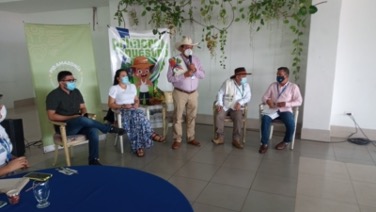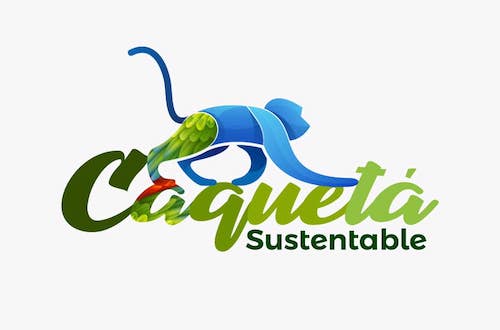New platform charts ambitious ‘green growth’ strategy for Caquetá
As climate change looms, governments worldwide are grappling with the challenge of securing economic growth and prosperity without sacrificing the environment. For tropical forest governments in developing nations—responsible for managing forests critical to our collective climate goals—that task is all the more formidable.
In Caquetá, Colombia, the regional government launched this week a new online platform that lays out its plans for meeting that challenge.
Developed by the Caquetá Secretary of Environment and Agriculture, in conjunction with Earth Innovation Institute, the regional sub-node of Climate Change, and the Caquetá Task Force, the Caquetá Sustentable platform embodies the Amazon region’s ambitious plan to achieve low-emission growth over the coming years. Officials and local stakeholders alike say they hope the platform will serve as the catalyst for transformational and lasting change.
“The Caquetá Sustentable platform is a clear signal that Caquetá is open for collaboration and open for business,” said EII Executive Director Daniel Nepstad in a recorded message delivered to attendees at the launch event. “I wish I could be there with you on this historic day to celebrate the result of many years of work to make Caquetá a prosperous region… as it advances toward green growth.”
The launch event, held in the Department capital, Florencia, brought together government officials as well as local stakeholders, including Yesid Meneses, Executive Director of RED Caquetá Paz, a local non-profit that trains area youth to report on forest and sustainability issues. “Articulating these processes is not easy, but we’ve succeeded,” he said. “This will represent the collective development of the territory.”

Rafael Torrijos Rivera, executive director of the Caquetá Cattle Ranchers Committee, noted some of the measures outlined on the platform have the potential to restore “up to one million hectares of degraded forest.”
Caquetá is one of six Departments located in the Colombian Amazon and is among the regions that saw some of the worst violence during the country’s five-decade long civil war, which ended in a peace agreement signed in 2016. Deforestation rates spiked shortly after as areas once controlled by guerilla forces were opened to agricultural expansion and economic exploitation.
Today the department has made important strides toward reversing that trend, helping spearhead the creation of the Administrative Planning Region (RAP) Amazon, among other steps. RAP seeks to strengthen alignment among Colombia’s Amazon departments with national climate policy and to take advantage of the growing opportunities for international climate finance.
Colombia recently increased its emissions reduction targets in its latest Nationally Determined Contribution (NDC), required of all signatories to the Paris Climate Accord. The new targets aim for a 51% reduction in emissions by 2050. Colombia’s NDC is among the most ambitious in Latin America. Achieving these targets will require significant reductions in deforestation and forest degradation in the country’s Amazon region, where a majority of forest loss now occurs.

EII began working with the government of Caquetá on the design and implementation of a low-emission rural development (LED-R) strategy for the region in 2018. The process has involved a wide range of stakeholders—including producer associations, indigenous communities, civil society organizations, and local officials—and reflects the kind of sweeping, bottom-up approach critical to achieving forest-, community-, and climate-friendly growth.
Identifying and reaching consensus on a set of clear goals and indicators for measuring progress, an action plan for implementation as well as financial mechanisms and incentives for local producers are just a few of the pieces involved in the years-long process, explains María Adelaida Fernández, who directs EII’s programs in Colombia.
“Our methodology is to work alongside regional governments to build a Territorial Performance System based on defining a low emissions development strategy with the government and all the actors,” she explained. “That is what we’ve been doing in Caquetá for the past four years and the platform is the culmination of all that work.”
She added, “This is an important milestone on our road to low-emission development in Caquetá. The platform integrates all of these achievements.”
Visitors to the platform are greeted by a message from Caquetá Governor Arnulfo Gasca Trujillo emphasizing the region’s commitment to sustainable development and urging residents to use the platform to stay abreast of the Department’s progress toward its goals. Trujillo also notes the platform will play an important role in “showcasing economic and investment opportunities that can promote an improved quality of life for all Caqueteños.”
Last year the governments of Norway, Germany and the United Kingdom pledged a total of $366 million to support Colombia’s efforts to reduce emissions from deforestation and forest degradation (REDD+) through the Joint Declaration of Intent agreement signed in 2015. Governments in tropical forest regions like Caquetá also hope to attract increased private sector financing through the recent growth of the voluntary carbon market and rising interest in jurisdictional offsets.
Fernández says the platform will play an important role in this regard.
“It’s like a living organism, it’s going to grow and adapt,” she noted. “The idea is for the territory to use the platform to show the world that Caquetá is committed to sustainable development, that it wants to do things differently and has a clear plan for how to achieve this.”
